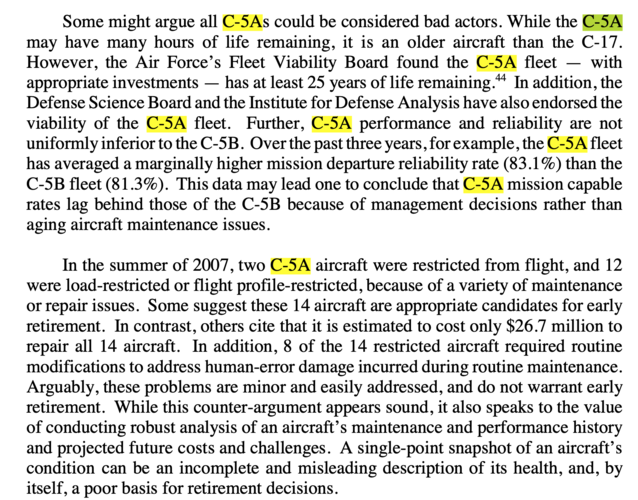"Air Force Upgrades C-5 Galaxy "
By Kris Osborn Wednesday, July 31st, 2013 5:51 pm
Source:
http://www.dodbuzz.com/2013/07/31/air-force-upgrades-c-5-galaxy-planes/
By Kris Osborn Wednesday, July 31st, 2013 5:51 pm
Source:
http://www.dodbuzz.com/2013/07/31/air-force-upgrades-c-5-galaxy-planes/
The Air Force is adding new engines to its hulking C-5 workhorse aircraft as part of a modernization approach designed to give the planes improved performance, reliability and fuel efficiency, service officials said.
The goal of the effort is to engineer a fleet of 52 new, upgraded C-5M Super Galaxy aircraft by 2017, replacing and upgrading some of the earlier A, B and C variants of the plane.
The massive aircraft, with 65-foot aircraft and 222-foot wingspan, is engineered to accommodate a maximum take-off weight of 840,000 pounds. Earlier variants of the aircraft, beginning with the first C-5A models which first flew in the late ‘60s, have served the U.S. military in a range of conflicts.
C-5 aircraft have hauled food, troops, fuel, weapons and ammo in Vietnam, Kosovo, Iraq and Afghanistan; the large planes are able to haul tanks, helicopters, artillery and other Army air-transportable equipment as well as standard pallets and troops around the battlefield.
Thus far, 11 C-5 planes have received what the service calls Reliability Enhancement and Re-engining modifications, or RERP, an effort which replaces a TF39 GE engine with a stronger, more reliable GE F138-GE-100 engine, said Air Force spokesman Ed Gulick.
“RERP is a comprehensive modernization to improve C-5 reliability, maintainability, and availability. It replaces TF39 engines and unreliable components to improve performance, fuel efficiency, range, and payload and throughput capability,” he said.
One analyst said adding a new engine brings a huge improvement to the plane.
“It is the only re-engining program the Air Force has initiated. Very few planes have every been re-engined. This is a great idea as it brings a tremendous improvement in range, payload and reliability,” said Richard Aboulafia, vice president of analysis at the Teal Group, a Virginia-based consultancy.
This RERP modification is not intended to extend the service life of the aircraft because the analysis leading up to this modernization effort had previously determined the C-5 was deemed capable of performing its mission through 2040, Gulick added.
“Certain modifications were needed to allow it to operate in a modern digital environment while also improving aircraft reliability, availability, and maintainability. The centerpiece for this modification is the replacement of the engine, which provides the capability to attain higher altitudes for air traffic management,” said Gulick.
While designed to improve reliability, the new engines also bring the added benefit of substantially increased fuel-efficiency for the planes.
During a recent mission in Afghanistan, two RERP-modified C-5Ms were able to match the performance of seven unmodified aircraft, Gulick said.
“While the seven unmodified aircraft flew 23 missions and moved approximately 1.6 million pounds of cargo, only two C‑5Ms were needed to fly 22 missions and move more than 2 million pounds of cargo due to their increased reliability,” he said.
The RERP program is expected to cost about $89.5 million per plane and $7.4 billion overall.
The C-5 aircraft have had some reliability issues over the years; at one point in the 1970s and 1980s, the Air Force realized that the plane’s wing structure would only be functional for up to 8,000 hours of the 30,000 hours expected for the overall service life of the plane; as a result, the service opted to replace the wing boxes using a new aluminum alloy, according to research from the Teal Group.
The RERP program is intended to build upon progress made during a prior C-5 modernization effort called Avionics Modernization Program, or AMP, wherein aircraft were engineered with a “glass cockpit” and other upgraded electronics and avionics.
“AMP avionics upgrades replaced unreliable components in the autopilot/flight augmentation systems and the flight and engine instrument suites. Additionally, navigation/safety upgrades, and an all-weather flight control system were included. Safety upgrades included a traffic alert and collision avoidance system and a terrain awareness and warning system,” Gulick mentioned.
The Air Force designed the RERP program so that it could synchronize with and build upon the technologies added during the AMP effort, a fleet-wide modernization effort going back to the late 1990s.
“C-5 modernization is a two-phase effort. Phase 1 was the Avionics Modernization Program (AMP) and Phase 2 is RERP. RERP provides an improved aircraft diagnostic system that assists maintenance personnel in the identification of malfunctions. Additionally, upgrades to system operating software provide capability growth for future operational requirements,” Gulick said.
As the C-5M matures through the RERP program, the Air Force anticipates it will bring the potential of an 8 to 9-percent increase in fuel efficiency compared to legacy C-5s, he added.

